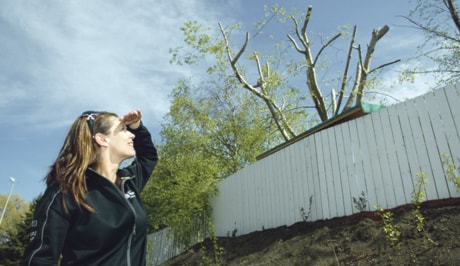A City of Red Deer urban forester is concerned with the practice of tree topping.
Also known as stubbing or dehorning, it involves cutting down all limbs into little stubs in order reduce the height of a tree.
Elaine Johnson said people usually top trees because they’re afraid the tree might fall on their home.
“That’s a real concern for anyone who has trees in their yards. The city takes safety with trees very seriously. We monitor all natural areas, all playgrounds and parks,” Johnson said.
But the solution doesn’t have to be so drastic. Eliminating a few limbs may do the trick, or it’s possible the tree may not need any pruning if it’s strong and healthy, said the certified arborist.
“Many people do take good care of their trees and really do care. I don’t want people to feel bad about what they’ve done because it’s already done,” Johnson said.
However, the result is a weakened tree with a shorter lifespan, by as much as half or more, she said.
People may notice that the city is actually topping trees in the 30th Avenue shelter belt near East Hill Shopping Centre. The poplars have dead tops due to nearby development and must be cut down for public safety.
She said it’s a last resort to maintain those trees for as long as possible as they are being replaced.
Johnson encourages homeowners to consult a certified arborist. They are trained in how to keep trees healthy.
Topping forces the homeowner to continue the severe pruning practice for as long as they have the tree. When a tree’s crowning glory is cut off, it actually triggers the tree to grow more leafy shoots out of its stumps at an even faster rate to manufacture food for the trunk and roots.
The thick regrowth makes the tree top heavy, more likely to catch the wind and be blown down in a storm.
Johnson said those new branches are weakly attached and are more prone to breakage.
If people have topped a tree, there’s no going back. But when the tree dies and if a new tree is planted in its place, hopefully the new tree is better suited to the location, she said.
“Lots of people will plant a big poplar or spruce and then they want to trim it so it’s a small tree. But they want to be big trees. That’s what their genetics tell them to do.
“Plant the right tree in the right place. Give them enough size and space to grow. Look at the mature size when you go to choose your tree.”
That also goes for homeowners redesigning their yards and future neighbourhoods where people will be planting trees.
Johnson said trees are a benefit to a community in many ways like producing oxygen and pulling carbon and pollution out the air.
To keep trees healthy, she also advises homeowners to give them a good soak in the fall and during spells in the summer if precipitation is limited.
“If they don’t water well in the fall, sometimes in the spring the trees will be struggling and stressed, and that can leave them open to invaders like fungus and insect pests.”
For more information on how to keep trees healthy, go to www.isa-arbor.com
szielinski@www.reddeeradvocate.com
